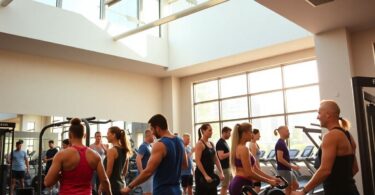Want to get better at free kicks in soccer? This guide is for you. We’ll go over everything from how to kick the ball just right to getting your head in the game. It’s all about practise and knowing what you’re doing. So, if you’re keen to improve your free kicks, stick around. We’ve got some good tips coming your way.
Key Takeaways
- Getting good at free kicks means you need to work on your technique and your mind.
- Eating right and looking after your body, especially your feet, helps you play better.
- Building muscle and moving well through different patterns makes your kicks stronger.
- Doing fitness tests helps you figure out what to work on in your training.
- Learning to stay calm and focused when taking a free kick is super important.
Mastering the Art of Free Kicks in Aussie Soccer: Your Ultimate Guide
So, you reckon you’re ready to bend it like Beckham, Aussie style? Free kicks in soccer can be a real game-changer, and this guide is here to help you nail ’em. We’re not just talking about blasting the ball and hoping for the best; we’re diving deep into the science, the training, and the mental game behind those sweet, sweet goals. Let’s get started, shall we?
The Competitive Edge in Free Kicks
Free kicks can be the difference between a win and a loss, especially in tight matches. It’s not just about power; it’s about placement, deception, and a cool head under pressure. Think of it as a set play where you’ve got a golden opportunity to score, and it’s all down to you and your team.
The Science of Free Kick Periodization Explained
Periodization? Sounds fancy, right? Basically, it’s about planning your training in cycles to peak at the right time. You wouldn’t sprint a marathon, would ya? Same goes for free kicks. It’s about building strength, technique, and then maintaining it all season long. Think of it like this:
- Off-season: Focus on building a solid base of strength and fitness.
- Pre-season: Start honing your technique and power.
- In-season: Maintain your skills and focus on game-specific scenarios.
Unlocking Success: The Ultimate Guide to Free Kick Preparation
Preparation is key, mate. It’s not just about rocking up on game day and hoping for the best. It’s about putting in the hard yards beforehand. This means everything from your diet to your warm-up routine. Think of it as building a house; you need a solid foundation before you can start putting up the walls. Make sure you have a solid footy success preparation plan in place.
Crafting the Perfect Free Kick Schedule
Optimising Weekly Free Kick Routines
Getting your free kick practise right each week is super important. Think of it like this: you wouldn’t just rock up to a game without warming up, would ya? Your free kick routine needs the same kind of thought. Aim for a couple of solid sessions during the week, maybe Tuesday and Thursday, then a lighter run-through on Saturday to keep things ticking over before the big game on Sunday. This way, you’re not flogging yourself but staying sharp. It’s all about finding that sweet spot between practise and recovery.
Strategic Meal Planning for Free Kick Performance
What you chuck in your gob makes a massive difference to your free kick power and accuracy. You need to fuel up properly, especially leading up to a game. Think about what you’re eating on game day – stick to stuff you know won’t upset your stomach. Timing is also key. Get some good food in before the game to keep your energy levels up, and then refuel afterwards to help your muscles recover. It’s like putting the right petrol in a V8 – you’ll get better performance. Here’s a sample meal plan:
| Meal | Time | Food |
|---|---|---|
| Pre-Game | 3 hours before | Pasta with light sauce, grilled chicken |
| Half-Time | During break | Banana, energy bar |
| Post-Game | After match | Protein shake, sandwich |
Prioritising Foot Health for Powerful Free Kicks
Look, your feet are your money-makers when it comes to free kicks. If your feet are buggered, your free kicks will be too. Don’t ignore any niggles or soreness. Get them checked out by a physio or podiatrist. Prevention is better than cure, right? Make sure you’re wearing the right soccer pants and looking after your feet with proper stretching and strengthening exercises. A few things to keep in mind:
- Regular stretching of your feet and ankles.
- Wearing supportive boots that fit well.
- Addressing any blisters or calluses promptly.
Ignoring foot health is like driving a car with flat tyres – you’re not going anywhere fast. Take care of your feet, and they’ll take care of your free kicks.
Strengthen Muscles, Load Patterns, and Move Through Planes for Free Kicks
In the world of Aussie soccer, getting your muscles strong, understanding how to load them up right, and moving well in all directions is super important for nailing those free kicks. It’s not just about being fit; it’s about using your body in the smartest way possible to get the most power and accuracy.
Understanding Muscles in Free Kick Execution
When you’re taking a free kick, it’s not just your legs doing all the work. Your core, back, and even your arms play a part in keeping you stable and helping you generate power. Think of your body as a chain – if one link is weak, the whole thing suffers. You need strong quads and hamstrings for the kick itself, a solid core for balance, and good upper body strength to keep everything aligned. It’s also about injury prevention. A well-conditioned athlete is less likely to succumb to the common injuries.
Injury Prevention Through Targeted Free Kick Training
No one wants to be sidelined with an injury, especially when you’re trying to perfect your free kicks. That’s why targeted training is so important. It’s about strengthening the muscles around your joints to protect them from strain.
- Warm-up properly before each session.
- Use proper technique to avoid unnecessary stress.
- Listen to your body and don’t push through pain.
Making sure you’re doing the right exercises and using the right form can make a huge difference in keeping you on the pitch and away from the physio.
Consistency in Free Kick Strength Training
Strength training isn’t something you can just do once in a while and expect results. It’s about being consistent and building up your strength over time. Think of it like building a house – you need a solid foundation before you can start adding the walls. Regularly tracking progress through strength testing and maintaining a training schedule is key.
Here’s a basic example of a weekly strength training plan:
| Day | Exercise | Sets | Reps |
|---|---|---|---|
| Monday | Squats | 3 | 8-12 |
| Tuesday | Hamstring Curls | 3 | 8-12 |
| Friday | Core Work | 3 | 15-20 |
| Saturday | Calf Raises | 3 | 15-20 |
Maximising Free Kick Performance: A Guide to Fitness Testing and Tailored Training Programmes

Fitness Testing: The Free Kick Benchmark
Fitness testing isn’t just some box-ticking exercise; it’s the bedrock of any serious free-kick improvement plan. Think of it as your starting point, showing you exactly where you’re at and what needs work. It’s about getting real data to inform your training, not just guessing. We’re talking about understanding your power, precision, and stamina under pressure. Without this baseline, you’re basically kicking in the dark.
Key Fitness Tests and Their Relevance to Free Kicks
So, what tests are actually useful for free kicks? It’s not just about how many burpees you can do. We need tests that mirror the specific demands of taking a free kick. Here are a few to consider:
- Power Test: Measure leg strength and explosiveness with a standing long jump or medicine ball throw. This translates to the force behind your kick.
- Precision Test: Set up targets at varying distances and angles. Track your accuracy percentage. This shows how consistently you can hit your mark.
- Stamina Test: Simulate taking multiple free kicks in a row, with short recovery periods. Monitor your performance drop-off. This reveals your ability to maintain accuracy under fatigue.
Individualised Free Kick Training Regimens
Generic training programmes are about as useful as a chocolate teapot. You need a plan tailored to your strengths and weaknesses. This is where the fitness testing data comes in. If your power is lacking, focus on strength training. If your accuracy dips under pressure, work on mental resilience. It’s about identifying your specific needs and crafting a football training programme that addresses them directly.
A tailored approach is key. Don’t just copy what the pros do. They’re at a different level, with different needs. Focus on your own development, based on your own data. This is how you’ll see real progress.
Here’s a simple example of how test results can inform your training:
| Test | Result | Training Focus |
|---|---|---|
| Power Test | Below Average | Strength training, plyometrics |
| Precision Test | Above Average | Maintaining accuracy under pressure simulations |
| Stamina Test | Average | Interval training, free kick endurance drills |
Remember, consistency is king. Stick to your tailored plan, track your progress, and adjust as needed. That’s how you’ll truly maximise your free kick performance.
The Psychology of Free Kicks: Mental Resilience on the Pitch
Free kicks aren’t just about bending the ball; they’re a massive mental game. You’ve got the pressure of the moment, the crowd roaring, and the weight of expectation all bearing down. Getting your head right is just as important as perfecting your technique. Let’s have a look at how to build that mental resilience.
Managing Anxiety for Spot-On Free Kicks
Anxiety can absolutely wreck your free kick. It makes you tense up, messes with your focus, and throws your timing off. One simple trick is to take a deep breath before you step up to the ball. It sounds basic, but it can really help calm your nerves. Another thing is to have a routine – something you do every time before a free kick. This helps you focus on what you need to do, rather than letting the pressure get to you. Visualisation is also key; picture yourself scoring that goal, feel the satisfaction, and let that confidence carry you through.
Mindfulness Techniques for Free Kick Focus
Mindfulness isn’t just some trendy buzzword; it’s a powerful tool for staying present and focused. It’s about being aware of your thoughts and feelings without getting caught up in them. For free kicks, this means focusing on the task at hand – the feel of the ball, your stance, your run-up – rather than dwelling on the consequences of missing. Try these:
- Breath Awareness: Focus on your breath to anchor yourself in the present moment.
- Body Scan: Pay attention to the sensations in your body, noticing any tension and consciously releasing it.
- Visualisation: Imagine yourself executing the perfect free kick, focusing on the details of your technique and the feeling of success.
It’s about training your mind to stay calm and focused under pressure. It takes practise, but it can make a huge difference to your performance.
The Role of Psychology in Elite Free Kick Performance
At the elite level, everyone’s got the skills. What separates the good from the great is often their mental game. Elite players use psychology to enhance concentration, manage pressure, and maintain confidence. They work with sports psychologists to develop strategies for dealing with anxiety, building resilience, and staying focused in high-pressure situations. They understand the importance of self-belief, but also the need to be realistic and self-compassionate. It’s a holistic approach that combines physical skill with mental fortitude. They also understand that sometimes, failure is inevitable, and it’s how you bounce back from that failure that defines you. They practise
Advanced Free Kick Techniques for Aussie Soccer

Alright, so you reckon you’ve got the basics down pat? Good on ya! Now it’s time to crank things up a notch and explore some of the more advanced free kick techniques that can really bamboozle the opposition and have ’em scratching their heads. We’re talking about the kind of stuff that makes highlight reels and leaves commentators speechless. Let’s get into it.
Perfecting the Knuckleball Free Kick
The knuckleball. It’s the stuff of legends, right? The key to a good knuckleball is minimising spin on the ball. You want it to float and dance in the air, making it a nightmare for the keeper to judge. Here’s a few things to keep in mind:
- Stance: A square stance, approaching the ball straight on.
- Contact: Strike the ball dead centre, using a hard part of your foot (laces).
- Follow-through: Minimal follow-through to avoid imparting spin.
It takes a heap of practise, but when you nail it, it’s pure magic. Think of it like trying to throw a baseball without spinning it – tricky, but oh-so-effective when you get it right. You’ll need to put in the hours to get the knuckleball technique down pat.
Mastering the Curved Free Kick
Want to bend it like Beckham? The curved free kick is all about using spin to your advantage. It’s about wrapping your foot around the ball to create that beautiful arc that curls away from the keeper. Here’s the lowdown:
- Angle of Approach: Approach the ball from an angle, not straight on.
- Foot Placement: Contact the ball on the outside (for a right-footed curler going right to left).
- Follow-Through: A full follow-through, wrapping your foot around the ball.
The amount of curve you get depends on how much spin you impart. Experiment with different angles and contact points to find what works best for you. Don’t be afraid to try new things and see what happens. It’s all about finding your own style and making it work for you.
The Art of the Dipping Free Kick
The dipping free kick is all about getting the ball to drop sharply in front of the keeper, catching them off guard. It’s a real crowd-pleaser when you get it right. It’s similar to the knuckleball, but with a slight topspin to bring the ball down quickly. Here’s how to give it a crack:
- Contact Point: Strike the ball slightly below the centre.
- Foot Motion: A quick, downward flick of the foot.
- Power: A good amount of power is needed to get the ball over the wall and dipping down.
| Technique | Spin | Trajectory | Difficulty | Keeper Reaction |
|---|---|---|---|---|
| Knuckleball | Minimal | Unpredictable | High | Hesitant |
| Curved | Sidespin | Arcing | Medium | Anticipatory |
| Dipping | Topspin | Sharp Drop | Medium | Delayed |
Remember, practise makes perfect. Get out there, experiment, and find what works best for you. With a bit of dedication, you’ll be banging in screamers in no time. Don’t forget the importance of footy tips to improve your game!
Common Free Kick Mistakes and How to Avoid Them
Overcoming Power Over Precision
Mates, we’ve all been there. You’re standing over the ball, picturing it screaming into the top corner, but then you shank it into row Z. Often, this comes down to prioritising power over precision. Instead of trying to blast the ball, focus on clean contact and placement. Think about where you want the ball to go, not how hard you can hit it.
- Slow down your run-up.
- Concentrate on hitting the sweet spot.
- Visualise the ball going exactly where you want it.
Remember, a well-placed free kick is far more effective than a powerful one that misses the target completely. It’s about finesse, not brute force.
Addressing Poor Body Positioning
Your body position is absolutely vital for a good free kick. If you’re not lined up correctly, you’ll struggle to get the right trajectory and power. Make sure your standing foot is planted firmly next to the ball, pointing towards your target. Your kicking leg should swing through smoothly, with your body following the motion. A good stance will help with free kick legend.
- Check your alignment before each kick.
- Ensure your standing foot is stable.
- Practise your run-up to maintain balance.
Correcting Inconsistent Follow-Through
An inconsistent follow-through can ruin an otherwise perfect free kick. You need to make sure you’re following through in the same way every time. This means your kicking leg should continue its motion towards your target after you’ve made contact with the ball. A proper follow-through helps with accuracy and consistency. It’s easy to get distracted by simulated holds, but don’t.
- Practise your follow-through without the ball.
- Film yourself taking free kicks to identify inconsistencies.
- Focus on completing the motion every time.
Wrapping It Up
So there you have it, a bit of a rundown on how to get better at free kicks in Aussie rules. It’s not just about kicking the ball hard, is it? You’ve gotta think about where you are, who’s around, and what the wind’s doing. Practise is a big deal, obviously, but also just getting comfortable with the pressure. Keep at it, try different things, and you’ll start seeing those kicks hit their mark more often. Good luck out there!
Frequently Asked Questions
How can I get better at taking free kicks in Aussie Rules?
To get really good at free kicks, you need to practise them a lot. It’s not just about kicking the ball; it’s about knowing where to aim, how much power to use, and how to make the ball curve or dip. Think about it like learning a new dance move – you gotta do it over and over until it feels natural.
Does what I eat really affect my free kick performance?
Absolutely! Your body needs the right fuel to perform well. Eating good food helps your muscles work their best and gives you the energy to keep going. Think of your body like a high-performance car; it needs premium fuel to run fast and smooth.
Why is foot health important for powerful free kicks?
Yes, looking after your feet is super important in footy! Your feet take a beating during a game, so keeping them strong and healthy helps prevent injuries. If your feet hurt, you can’t kick as well, right? So, make sure they’re in top shape.
What’s the point of fitness testing for free kicks?
Fitness tests are like a report card for your body. They show coaches what you’re good at and what you need to work on. This helps them create a training plan just for you, so you can improve your speed, strength, and endurance for those crucial free kicks.
How do I handle nerves when I’m about to take a free kick?
It’s totally normal to feel a bit nervous before a big free kick. The trick is to learn how to calm your mind. Things like taking a deep breath, focusing on one small thing, or even just telling yourself you can do it can make a huge difference. A calm mind helps you kick straight and true.
What’s the difference between a knuckeball, curved, and dipping free kick?
The knuckeball, curved, and dipping free kicks are all about making the ball do cool things in the air. For a knuckeball, you hit the ball in a way that makes it wobble and drop suddenly. A curved kick makes the ball bend around the defence, and a dipping kick makes it go up and then quickly down. Each one needs a different way of hitting the ball, but they’re all super effective when done right!








